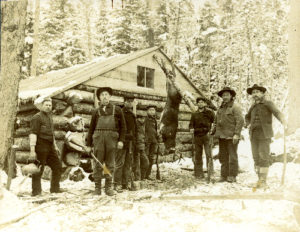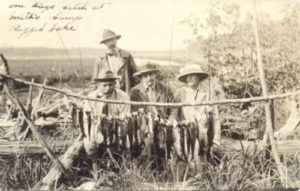 It’s not the first time people have looked to remote locations during health emergencies — in fact, Maine was a popular refuge destination during the Spanish Influenza Pandemic in 1918. What can we learn from these migrations that can help us navigate today’s crisis?
It’s not the first time people have looked to remote locations during health emergencies — in fact, Maine was a popular refuge destination during the Spanish Influenza Pandemic in 1918. What can we learn from these migrations that can help us navigate today’s crisis?
Maine Wilderness as a Destination
In the late 1800s and the early 1900s, sportsmen made the trek to Maine’s forests, rivers and lakes in search of wildlife. Moose, deer, ducks, and fish all were the game that city folks sought in Maine. Hotels once built to house the loggers who harvested the great forests of Maine now accommodated hunters and fishermen from New York, Boston, and Philadelphia. And, during the circa 1918-19 pandemic years, these hunters would bring their families to enjoy the clean water and fresh air at these remote camps and hotels. The trains stopped in Masardis, and from there, these intrepid city dwellers would travel to their final destination, sometimes several days of travel via canoe or wagon.
Aroostook as Refuge
We spoke to Al Cowperthwaite, Executive Director of North Maine Woods, Inc., about how Aroostook County and other remote areas of Maine became a refuge away from disease in the cities. Cowperthwaite helped produce a video detailing the historical aspects of hunting and fishing sports in Maine. In the video, visitors “from away” travelled to unpopulated Maine to save their families from the deadly Spanish influenza. They stayed in places named for the industry upon which the towns were founded. They included towns like Ore Mountain, Katahdin Iron Works and Blood Brook— so called because of the iron tailings that turned the water red. There, these sportsmen and their families  summered to escape the dangerous conditions in the cities.
summered to escape the dangerous conditions in the cities.
Cowperthwaite noted that his organization is seeing similar trends since the outbreak of the novel coronavirus, COVID-19. His organization oversees 35 million acres in Northern Maine for the owners, managing access to private roads that lead back into the Maine wilderness. Each May through November the team at North Maine Woods registers some 80,000 visitors, 800 private camps, and operates 350 of their own campsites. “We clean up the roads, provide security and explain how things work in these privately held forests,” Cowperthwaite explained. He works with 65 employees and more than 100 Maine Guides and sport camp operators to monitor the flow of people in and out of the properties. The staff has noticed a marked early season increase in visitors to the lands the organization supervises.
So, what does this mean for the present? The situation on the ground in many places is a moving target. While there may be varying degrees of regulations in effect in your desired refuge location —Maine or elsewhere— it doesn’t prevent you from starting to make plans. At Katahdin Cedar Log Homes, we’re ready to assist you with that. We can answer your questions about building your log home and provide some positive strategies to move forward. We look forward to hearing from you!
